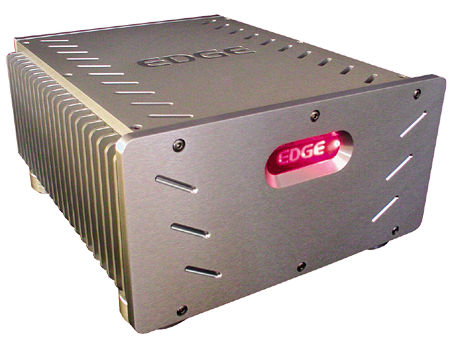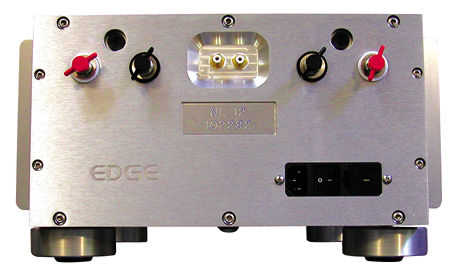| Columns Retired Columns & Blogs |
Edge NL-12 power amplifier
Consider the plight of solid-state muscle amps. Often derided as brutes lacking sophistication or subtlety, particularly by the SET set (ie, fans of single-ended triodes), these powerhouses are taken for granted and often, like Rodney Dangerfield, they get no respect. And once upon a time, the stereotypes were true. Every veteran audiophile has at some time heard an immensely powerful transistor amp that had the soft sonic allure of a sheet of sandpaper, a lumbering oaf of a component with nothing whatsoever to recommend it save for a bulging set of mighty moose muscles.
Footnote 1: See "Sam's Space" in March 2003 for a discussion of the benefits of this.—John Atkinson

The Edge NL-12 is a massively powerful solid-state amp—at 300Wpc, it qualifies as a board-breaker of the first order—but it's a muscle amp built from a different perspective. On my first hearing of the NL-12 at a Consumer Electronics Show a few years back, I was instantly struck by its delicacy and finesse when playing an Emmylou Harris CD. This was no "conventional" high-power amplifier. A chat with Edge's marketing director, Steven Norber—a friendly fellow who combines intensity and mellowness—at Home Entertainment 2003, and an NL-12 was dispatched for my edification.
What's different about the NL-12 begins with its sleek, art deco-ish appearance. Shapes are softly rounded; even the hefty cooling fins can't gouge the hands. While this is a powerful amp, it doesn't look particularly large or imposing, though it's certainly handsome. But be warned: the Edge is far more heavy than you'd think it is. As my review sample was equipped with the optional engraved top panel of transparent Lucite, I quickly discovered why it had seemed as if I was pulling an engine block out of the box: enormous dual-mono toroidal transformers live within, topped by nicely machined crowns of power-supply capacitors. The internal design is clean and well organized, with minimal wire snaking around inside. Stylish inside and out is the NL-12, as might Yoda it put.
Edge Electronics has been slowly and carefully building their reputation and expanding their product line since 1987, and now produces a full line of line stages and power amplifiers. The $15,500 NL-12 is the company's most potent stereo amplifier; above it are the $35,000/pair NL Signature One 400W monoblocks and the monumental 800W Reference monoblocks, which are built to order and will set you back about 75,000 bucks. Now there's a muscle amp.
Circuits
The NL-12's circuit uses bipolar transistors, and is given its backbone by those enormous, stainless-steel-clad transformers. The power supply is optimized to operate within a specific temperature range. Not that the NL-12 ever got much more than moderately warm, even when blasting power music through the Focal-JMlab Nova Utopia Be loudspeakers, which John Atkinson's measurements in June revealed to be a less than forgiving load.
Norber and chief engineer Tom Maker describe the NL-12 amplifier's output-stage topology as "quasi-complementary," meaning that, like Plinius, Edge uses NPN transistors in place of the usual PNPs (footnote 1). The Edge technical white paper I received argued that NPN transistors differ greatly from PNPs in linearity "and the parameters that account for linearity—beginning with the doping of the [transistor's] silicon substrate." The output transistors are matched to tolerances tighter than 1% and are supposedly driven with increased amounts of current in order to minimize the already small differences between the individual transistors' response curves. A "judicious" amount of local negative feedback is used in the interests of stability.
The exclusive use of NPN devices is also said to minimize crossover and switching distortions. Somewhat obliquely, the white paper notes that the NL-12 "offers the sought-after attributes of Class A operation." Whether this means the amp runs in class-A or that Edge expects reviewers to rate it Class A. Given that it never became overly warm, I suspect that the NL-12's output stage operates in the usual class-AB.

The most unusual feature of a number of Edge amplifiers is their use of a laser biasing circuit. A chip diode that produces red coherent light with a wavelength of 630 nanometers is coupled with the bias transistor in a hermetically sealed, transparent chamber (which glows a nifty red when observed through the amp's clear top). Inside the chamber, the laser is focused directly on the transistor's substrate, and the laser is modulated by a servo that's tied to the signal for exact bias tracking in response to varying signal inputs. Edge asserts that the upshot is a "more efficient movement of electrons as seen in a 400% increase in transistor gain" over a non-laser-biased circuit.
The speaker terminals are unique: heavy-duty washers fused to T-handles that screw into holes on the amplifier's rear panel: easy to tighten, simple, and effective.
Setup
When the Edge arrived, I discovered that it accommodated only RCA input jacks. An e-mail to Steve Norber resulted in the quick delivery of a pair of beautifully made Cardas female XLR-to-male adapters, which I used for all evaluative listening. As my usual Grand Prix Monaco amp stands were full of amps, the Edge, like the Hovland Radia, was perched atop three StillPoints isolation feet. Given its weight, it's safe to say that the NL-12 was securely coupled to the slab beneath the thin carpet of my listening room.
Footnote 1: See "Sam's Space" in March 2003 for a discussion of the benefits of this.—John Atkinson
- Log in or register to post comments




































